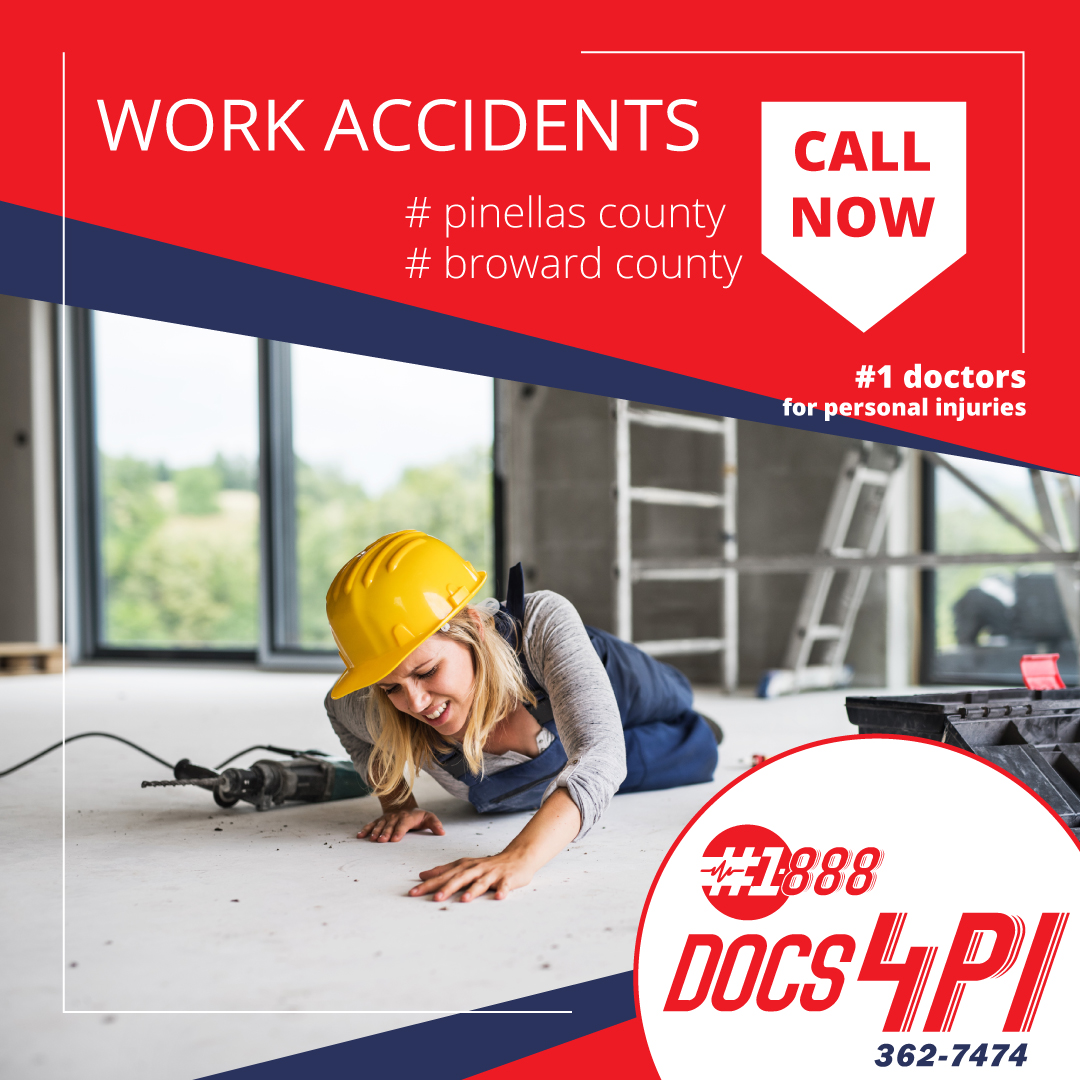Work Accidents: Everything You Should Know
Work Accidents: Everything You Should Know
An increase in workplace health and safety measures has led to a decrease in the number of work-related injuries and fatalities over the years. The Occupational Safety and Health Association (OSHA) reports that daily occupational fatalities have decreased from 38 a day in 1970 to 15 today. However, there is still a long way to go before there are no occupational fatalities. A major cause of work-related injuries is slips, trips, and falls, overexertion, and contact with machinery. OSHA guidelines and proper precautions can prevent most of these injuries. We will discuss the most common work-related injuries in this article and provide some recommendations on how to prevent them. Do not wait to seek medical treatment if you are currently suffering from a workplace injury. Despite seeming minor, injuries from falls, overexertion, burns, etc. can progress over time and cause serious complications in the future. Among the most common work accidents you should be aware of include:

1. Slips, trips and falls.
Regardless of the work setting you are in you can assume that you are bound to encounter slippery surfaces at some point, so it isn't impossible that you may end up having an accident. Those who work at height face the risk of falling from ladders and scaffolding as well as falling from other platforms. In the construction industry, falls are the leading cause of worker deaths. Builders are constantly exposed to the risk of falling from a roof, ladder, scaffolding, platform, stairway, or other elevated surface. Poorly built structures and improperly used safety equipment are often the cause of these accidents. OSHA requires fall protection for workers who work at certain heights or operate dangerous equipment and machinery. Furthermore, safety training and employee diligence can reduce the risk of falls.
-
Motor Vehicle Accidents.
Those who drive for a living are at risk of negligent drivers, inclement weather, and defective automotive equipment. Each of these factors can lead to a car or trucking accident. Accidents can also be a serious risk for workers who work around moving vehicles. At a construction site, a worker could be struck by a tractor, or a worker in a warehouse or factory could collide with a forklift. Business owners should emphasize safe driving policies, which emphasize defensive driving and prohibit distracted driving. There are, however, circumstances in which a motor vehicle accident is caused by someone other than a co-worker or employer. In such a case, you may be able to bring a claim against a third party. A claim of this kind can result in compensation that extends well beyond workers' compensation benefits.
-
Overexertion.
One of the most common causes of work-related injuries are lifting, pushing, holding, carrying, and throwing. Overexertion injuries may occur in a single incident. The effects of a daily, strenuous activity may build up over time. Injuries to muscles, tendons, and ligaments can occur if a worker slips or trips without falling. There are many long-term effects of overexertion, from lower back injuries to arthritis. Workplaces should train their employees on how to perform physical tasks like heavy lifting properly to avoid overexertion. In addition, workers should be provided with proper equipment and given plenty of breaks. The same precautions should be taken against overexertion hazards encountered externally, including training, protective gear, and frequent breaks. A slippery surface, a cluttered area, or an uneven surface need to be cleaned or labeled promptly.
-
Repettitive Strain Injuries.
Work-related repetitive stress injury is another problem that has become more common over the years, although some employers don't appear to take this problem very seriously. It doesn't just affect those who regularly type on a keyboard at work -- it can affect anyone who performs repetitive movements of the joints. In some cases, RSI can create serious long-term consequences, so it is important to avoid it. To prevent RSI, employers should encourage and remind workers to take regular breaks. In addition, ergonomic equipment, such as hand trucks, can help reduce strain.
-
Electrocution.
When working around exposed cords or wires, workers can suffer electrocution-related injuries. Defective electrical outlets may also cause injury. Working around power lines or hitting underground cables can cause electrocution in some cases. All electrical hazards should be identified, and employees should be given appropriate warnings.
-
Struck by Objects.
Serious injuries can result from being struck by an object falling from above or being thrown by a person or piece of machinery. Objects falling from the sky, flying, rolling or swinging can cause blunt-force trauma, which can cause fractures, organ injuries, eye injuries, cuts or bruises. Head injuries are the most common injuries caused by falling objects. Injuries can be prevented by stacking materials safely and posting warning signs at areas where debris might fall. In addition, management should ensure that employees wear protective equipment, such as hard hats and safety glasses.
-
Being Struck Against.
If a worker runs into a wall, door, cabinet, window, machinery or a vehicle unintentionally, they may suffer head, knee, neck or foot injuries. Accidents sometimes occur because workers do not pay attention to their surroundings. In the U.S., for example, cell phone use has increased eightfold in the past 15 years, and pedestrians have walked into walls and other motionless objects at an alarming rate, according to the National Safety Council. Employers should require workers to maintain clutter-free workplaces and clearly mark hazards and obstacles in order to reduce the risk of these accidents. Furthermore, companies should establish policies that forbid workers from talking or texting on their phones while at work.
-
Inhaling Toxic Fumes.
When exposed to hazardous chemicals without protection, most of us are at risk for skin or eye reactions, as well as potential more serious injuries. Providing workers with protective equipment, such as safety goggles, is essential in these situations, so employers should make sure to provide the gear they need to stay safe.
-
Entaglement.
Workers can suffer tearing and crushing injuries from heavy machinery gears, rollers, and other parts. The most severe cases may result in limb loss or death. This type of accident is usually caused by loose clothing, shoes, jewelry, fingers, or hair getting caught in machinery. Workers should be trained on how to identify and prevent entanglement hazards. Employees should also be provided with protective equipment and signs and barriers should be placed around potentially dangerous machines.
-
Violence or Fights at Work.
Despite what you might think, fights breaking out in a workplace are not that rare. Tensions at work can simmer for months or years before erupting into physical confrontations. It is not surprising that workplace fights can lead to nasty injuries. It is possible to reduce the risk of conflicts between employees arising through effective grievance management procedures. Workers may also confront domestic violence issues at work. Public-facing workers, like delivery personnel, are exposed to assaults from customers or others, as well as attacks from dogs. Employers must provide their employees with violence training, set up communication channels for reporting suspicious behavior, and encourage communication among employees.
What Your Employer Should Do After a Workplace Accident
Is your employer following these steps to get a workplace accident reported in a timely manner? In the event of an accident on the job, first assess the injury. Often, time is of the essence when it comes to a medical response. If there is a safety site supervisor or medical response team at the company, they should be notified immediately. Whenever a life is at risk, a member of the team or employer should call 911. Employers suffering less serious injuries should consult the workers' compensation provider assigned to their company — or a care provider at a walk-in clinic near their workplace. Even in cases where there is no life-threatening injury, some insurance providers have claims management partners who can call a nurse 24-hours a day.
Next, a serious accident site should be secured as quickly as possible. Employees should be restricted from accessing the scene of an accident in order to preserve evidence and prevent further accidents. Materials and equipment associated with the incident should also be secured. Immediately following the accident, it should then be reported. If possible, the employer should speak to witnesses, take photos of the accident site, and comply with OSHA's reporting and recordkeeping requirements. Using OSHA form 300, employers must keep track of work-related injuries and illnesses. OSHA requires all employers to report deaths on the job and amputations, amputation-related hospitalizations, and eye loss resulting from the work environment. Reporting a fatality within eight hours of the accident is federally mandated, whereas hospitalization, amputations, or loss of eyesight should be reported within 24 hours. In the accident report, employers must be honest and accurate; if OSHA finds discrepancies or inaccuracies in the report, they can charge fines or penalties. Within 24 hours of the accident, the company's workers' compensation insurance carrier should receive a state-specific "First Notice of Loss." Although the injured employee is ideally available to discuss the claim, the employer may contact the insurance carrier on their own if the employee is unable to do so.
Contact 1-888-DOCS4PI if you've been injured on the job. Our medical staff is prepared will be able to properly treat your injuries, document your medical history, and contribute any other necessary documents that will help your personal injury claim.

